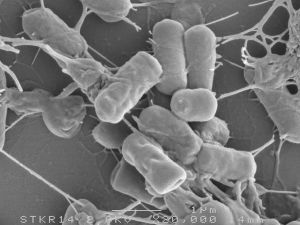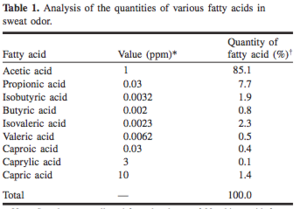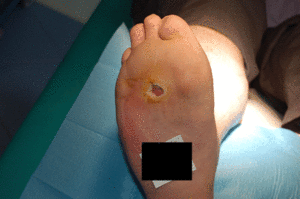Foot Odor Microbes: Difference between revisions
Carmichaelh (talk | contribs) |
Carmichaelh (talk | contribs) |
||
| Line 1: | Line 1: | ||
== | ==Introduction== | ||
[[Image:Bacillus subtilis natto.jpg|thumb|300px|right|Electron micrograph of the Bacillus sibtilis natto, a microbe associated with foot odor. Taken by Zweers et al. in microbial cell factories 2008 http://microbialcellfactories.biomedcentral.com/articles/10.1186/1475-2859-7-10.]] | [[Image:Bacillus subtilis natto.jpg|thumb|300px|right|Electron micrograph of the Bacillus sibtilis natto, a microbe associated with foot odor. Taken by Zweers et al. in microbial cell factories 2008 http://microbialcellfactories.biomedcentral.com/articles/10.1186/1475-2859-7-10.]] | ||
<br>What microbes are associated with foot odor? What benefits, if any, do these microbes serve for humans? What metabolic processes do these microbes have that lead to the odors they produce? []<br> | <br>By Heath Carmichael | ||
<br>What microbes are associated with foot odor? What benefits, if any, do these microbes serve for humans? What metabolic processes do these microbes have that lead to the odors they produce? What diseases might be caused by these microbes? []<br> | |||
Bromodosis is the medical term for having foot odor. Many people worldwide suffer from Bromodosis. Bromodosis is caused from microbes that metabolize dead skin cells from peoples feet to smelly molecules. This is an even bigger problem for people who run because sweat provides an ideal growth environment for foot microbes. Some think that the odor is caused by sweat. This is untrue because sweat is odorless, but the microbes that live on feet grow better because of the moisture provided by sweat. Another contributor to foot odor is the type of socks that people choose to wear. Socks constructed of synthetic material like nylon and polyester provide less ventilation for peoples feet and therefore increase the amount of sweat produced. Wool or cotton socks do a much better job at providing more ventilation for feet so less sweat is produced. A study was done to test the amount of microbial growth on cotton t-shirts versus synthetic t-shirts and the results were that Firmicutes, Actinobacteria and Proteobacteria were found in both types of shirts, but Micrococci were found in much more abundance on synthetic t-shirts (Callewaerta et al. 2014). Micrococci are gram positive actinobacteria and when under anaerobic conditions they can produce acid from glucose (Microbewiki, Micrococcus). The anaerobic conditions on synthetic shirts were most likely due to the poor ventilation of these shirts compared to the ventilation of cotton t-shirts. Wearing the same shoes consistently is also a cause of foot odor because it does not allow proper time for shoes to “air out” and reduce the amount of moisture inside the shoes. | |||
==Section== | ==Section== | ||
Revision as of 17:12, 26 April 2016
Introduction

By Heath Carmichael
What microbes are associated with foot odor? What benefits, if any, do these microbes serve for humans? What metabolic processes do these microbes have that lead to the odors they produce? What diseases might be caused by these microbes? []
Bromodosis is the medical term for having foot odor. Many people worldwide suffer from Bromodosis. Bromodosis is caused from microbes that metabolize dead skin cells from peoples feet to smelly molecules. This is an even bigger problem for people who run because sweat provides an ideal growth environment for foot microbes. Some think that the odor is caused by sweat. This is untrue because sweat is odorless, but the microbes that live on feet grow better because of the moisture provided by sweat. Another contributor to foot odor is the type of socks that people choose to wear. Socks constructed of synthetic material like nylon and polyester provide less ventilation for peoples feet and therefore increase the amount of sweat produced. Wool or cotton socks do a much better job at providing more ventilation for feet so less sweat is produced. A study was done to test the amount of microbial growth on cotton t-shirts versus synthetic t-shirts and the results were that Firmicutes, Actinobacteria and Proteobacteria were found in both types of shirts, but Micrococci were found in much more abundance on synthetic t-shirts (Callewaerta et al. 2014). Micrococci are gram positive actinobacteria and when under anaerobic conditions they can produce acid from glucose (Microbewiki, Micrococcus). The anaerobic conditions on synthetic shirts were most likely due to the poor ventilation of these shirts compared to the ventilation of cotton t-shirts. Wearing the same shoes consistently is also a cause of foot odor because it does not allow proper time for shoes to “air out” and reduce the amount of moisture inside the shoes.
Section

Section

Reference
[1] Jessica C Zweers, Imrich Barák, Dörte Becher, Arnold JM Driessen, Michael Hecker, Vesa P Kontinen, Manfred J Saller, L'udmila Vavrová and Jan Maarten van Dijl. "Towards the Development of Bacillus subtilis as a Cell Factory for Membrane Proteins and Protein Complexes". Microbial Cell Factories. 2008. 7:10
[2] Katsutoshi Ara, Masakatsu Hama, Syunichi Akiba, Kenzo Koike, Koichi Okisaka, Toyoki Hagura, Tetsuro Kamiya, and Fusao Tomita. “Foot odor due to microbial metabolism and its control”. NCR Research Press. 2005.
[3]Luca Dalla Paola, Anna Carone, Lucian Vasilache, Marco Pattavina. “Overview on diabetic foot: a dangerous, but still orphan, disease”. European Heart Journal. 2015. A64-A68.
